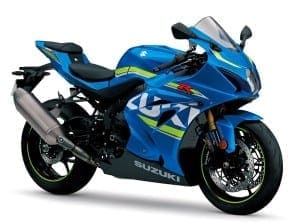Well Well Well, a new GSXR-1000 is being rushed out, looks similar to the old model, but a raft of changes, 200hp, 10 settings TC (no antislide or anti-wheelie) launch control Variable Valve Timing, it will be a 2017 model but available mid 2016
Suzuki are claiming that it’s the lightest, most powerful and best handling GSX-R they’ve ever built, and there’s little reason to doubt any of that. This 6th generation GSX-R1000 is also the highest spec’d ever, with multi-mode traction control, rider modes, ABS, ride-by-wire throttle, bi-directional quickshifter, an all-new engine and all-new chassis.
Suzuki GSX-R1000 L7 highlights
All-new 999cc engine
200bhp | 82ftlb | 200kg (est)
All-new aluminium chassis
Showa BFF fork and BFRC shock
10-level traction control
Quickshifter/autoblipper
The code-conscious will notice the significance of the L7 designation, which clearly marks this out as not being a 2016 model year bike, but don’t be too disappointed – the bike will arrive in 2016, just like the GSX-S1000 L6 models arrived in the middle of 2015.
Key to the new bike’s positioning within the superbike segment will be its price. Suzuki are fully committed to making the GSX-R affordable, and while they’ve given no firm indication of price, they have consistently indicated that it will be significantly more affordable than its nearest competitors. In real terms that points to the top spec GSX-R arriving at around £13,000. The fascinating bonus is that we believe there will be a lower-spec version which could cost as little as £11,500. While Suzuki haven’t explicitly confirmed this model, there are images of a lower-spec version (the one with the black silencer and lower-spec fork), and Suzuki have often hinted that would be two models.
GSX-R1000: best in class
Suzuki say they’re targeting the mantle of ‘King of the Sportsbikes’, and they’re determined to do it in their own way. Their design team have pushed for engineering solutions to make the perfect sportsbike, rather than relying on electronics to solve engineering issues. It’s the same approach they’ve taken with the MotoGP bike – and look how incredibly well that performed in 2015.
It’s not bereft of electronics though. Ride by wire electronic throttle bodies, a 10-level Traction Control System, S-DMS (Suzuki Drive Mode Selector), Electronically controlled ABS, a quickshifter system and launch control system add up to a decent raft of electronic assistance.
Suzuki’s traction system allows the rider to select three different power modes and 10 different levels of traction control, to match road or track conditions. Both parameters can be changed while riding as long as the throttle is closed, too. Just like all its main competitors, the new Thou also gets a quickshifter and autoblipper, allowing the rider to shift both ways through the ’box without using the clutch. Traffic light GPs will also benefit from the new launch control system. There’s no Bosch Inertial Measurement Unit (IMU) though, as fitted to some competitors – Suzuki say the rider just won’t need it.
Suzuki Variable Valve Timing
While the engine is all-new, the headline-grabbing change is the introduction of variable valve timing – a first for a production superbike. Steel balls are positioned in grooves in the intake cam sprocket and adjacent guide plate, which are then moved outward by centrifugal force, which means the stack in different grooves at low and high rpm, rotating the intake cam at high rpm, retarding intake cam timing. The result is optimised valve timing at all rpm, benefiting high, mid and low-rpm responsiveness, power, and torque.
It also gets the GP bike’s Suzuki Racing Finger valve train follower rocker arm to improve valve control and allow higher rpm, while the Suzuki Exhaust Tuning-Alpha (SET-A) and Suzuki Top Feed Injector (S-TFI) systems, which all combine to make what Suzuki call their Broad Power System. This was the ethos behind the GP bike, and the result is strong, linear acceleration throughout the rev range.
GSX-R1000 takes Showa
The other engineering solution to a problem many other manufacturers are solving with electronics is the Showa suspension. The new GSX-R gets Showa’s excellent Balance Free Front fork – a race-developed unit capable of coping with a far wider range of surfaces and conditions than a conventional fork, boasting full adjustability – and no wires. This will be one of the casualties on the cheaper model, which appears to get a conventional Showa fork.
Keeping the new minimalist swingarm under control is the latest version of Showa’s Balance Free Rear Cushion (BFRC) shock. The fully-adjustable unit is lighter and more efficient than previous versions, and super-compact.
GSX-R1000: lightyears ahead
The new bike is visually more compact, sharper, and lighter, while Suzuki say it’s also dramatically more aerodynamic. This is all complimented by fully-LED lighting and indicators (both seemingly missing from the cheap version), and an all-new full LED dash that crams a mass of information into its display.
Expect the all-new GSX-R1000 to arrive in dealers towards the middle of 2016 as a 2017 model, hopefully with both versions appearing in close succession.

